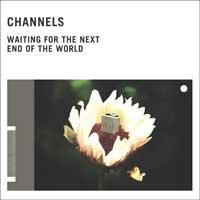J Robbins' bands have often played second fiddle to the various projects surrounding Ian Mackaye and his Fugazi bandmates, with Jawbox rarely being mentioned without D.C.'s most venerated post-hardcore band being close at hand. Yet Robbins, who has carved a niche for himself as a rather renowned producer, has been one of the strongest stalwarts of the Dischord roster, making his new project, Channels, an obvious necessity to Dischord purists, and a strong group in their own right. Now that Fugazi's members have drifted in somewhat different directions, Channels remain as the most direct evolution of the sound of `90s Dischord as purveyed by both Jawbox and Fugazi.
Robbins has said the tastes that brought Channels together were XTC and the Jesus Lizard, and Channels' sound can indeed be labeled as an application of these two acts onto the sound of Jawbox and Burning Airlines. What this means is that Waiting for the Next End of the World is simultaneously grindingly forward-pushing and full of upbeat energy. Generally, the rhythms are pounding and intense, while the melodies are quite catchy and intricate. This leads to an overall evocation of both angry resolution and giddy energy, and the album works best when that tone is maintained, with the best examples being the infectious opener "To the New Mandarins" and the overall strongest song on the album, "Chivaree."
While "Helen Mirren" provides some nice relief to the otherwise frenetic first part of the album, it and its slow compatriot, the closing "Mercury," definitely feel like the weakest tracks -- the latter seems to be an anticlimax to the energy infused by the rest of the album, with "Little Empires" being a much more satisfying finish. Overall, though, the album is coherent and energetic without resorting to being obviously "fun," allowing for some rather intense moments and even more poignant lyrics.
Robbins has always written some great lines, and his songwriting is if anything at its strongest here. The album is littered with gems like "I grew up on science fiction / Doesn't mean I want to live in it," but the real lyrical standout is "New Logo," framing the end of the world as commercial entertainment. Never has the end of the world sounded so disturbingly cheerful, thanks to lines like "Crows are crowding every open wire / the starting guns all turn and open fire" and "test audience prefers the fire to flood in every demographic, ten to one."
Robbins' vocal technique has also improved, with his range sounding great. His fellow vocalist is a bit less impressive, though: Robbins' wife Janet, while possessed of a nice-sounding voice and a capable backup singer, disappoints when she takes the lead for "Hug the Floor," sounding a bit flat but more pressingly slipping into the mix so that her vocals seem to lose the focus of the song. This may be more of an aspect of Robbins' production being so closely linked with his voice, but regardless makes the otherwise good song fall short. Fortunately, the two following songs are the two strongest on the album, with the urgent and accusatory "Mayday" being a great example of the band at its best. And when they're good, they're really good.
Of the twelve songs present, nine are incredible, and the three weaker tracks are still strong enough to make this a very good album, and with all due respect to both Ian Mackaye and Joe Lally, that makes Channels' Waiting for the Next End of the World Dischord's best album of 2006.
